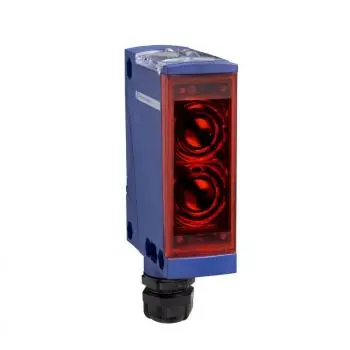
A photoelectric sensor (or optical sensor) is a device that uses light energy to detect the presence or absence of objects or materials. It works by converting light into an electrical signal that can be interpreted and used by a control system.
There are different types of optical sensors, but in general, they all consist of a light source (usually an LED or a laser), a light receiver, and a signal processing circuit. When the light emitted by the light source is blocked or reflected by an object, the light receptor detects the change and generates an electrical signal indicating the presence or absence of the object.
Photoelectric sensors are used in a wide variety of applications, such as industrial automation, security, or home automation.
Types of photoelectric sensors
There are several types of photoelectric sensors, some of which are described below:
-
Barrier sensors: This type of sensor consists of a light source and a light receiver placed on opposite sides of a detection zone. When an object blocks light between the source and receiver, the sensor detects the presence of the object.
-
Reflection Sensors: This type of sensor uses a light source and a light receiver placed side by side. The light emitted by the source reflects off an object and returns to the receiver, allowing the sensor to detect the presence of an obstacle.
-
Retroreflection Sensors: These sensors work similarly to reflection sensors, but instead of reflecting off an object, the light emitted by the source is reflected by a mirror placed behind the object and returned to the receiver.
-
Direct detection sensors: These sensors use a light source and a light receiver placed in the same location. The sensor detects the presence of an object when the light emitted by the source is blocked by the object and does not reach the receiver.
-
Fiber optic sensors: These sensors use an optical fiber to transmit light from the source to the object and from the object to the receiver. This enables detection in tight spaces and in applications where sensors must be located in hard-to-reach areas.
Operation of a photoelectric sensor
The basic operation of a photoelectric sensor involves the emission of light by a light source, the interaction of this light with an object, and the detection of changes in the light by a light receiver.
In general, they work as follows:
The light source emits light in the detection area. The light emitted can be visible, infrared light or laser, depending on the application. If an object is present in the detection zone, the emitted light may be reflected, absorbed or transmitted by the object. The light receiver then detects changes in the quantity or quality of light returning to the sensor after interacting with the object.
Finally, when a change in light is detected, the light receiver generates an electrical signal that can be used by a control system to perform an action.
The exact way a photoelectric sensor works depends on the type of sensor being used. For example, barrier sensors use a light source and receiver placed on opposite sides of the detection zone, while reflection sensors use a single component that combines a light source and receiver.
Uses and applications: what is a photoelectric sensor for?
Photoelectric sensors are used in a wide variety of applications due to their ability to detect the presence of objects accurately and reliably. Some of the most common applications include:
- Industrial automation: Photoelectric sensors are used to detect the presence of parts on a production line, allowing production control and error elimination.
- Security: Optical sensors are used in security systems to detect the presence of people or vehicles in a restricted area, such as in automatic doors or access control systems.
- Lighting: Used in lighting systems to adjust the light level based on available natural light, which can help save energy and reduce lighting costs.
- Home Automation: Home automation systems use photocells to control lighting, heating and ventilation in a home or building.
- Automobile: Photoelectric sensors are used in obstacle detection systems and automatic braking systems in some vehicles to improve driving safety.
- Medicine: Optical sensors are used in medicine to measure light absorption by biological tissues.